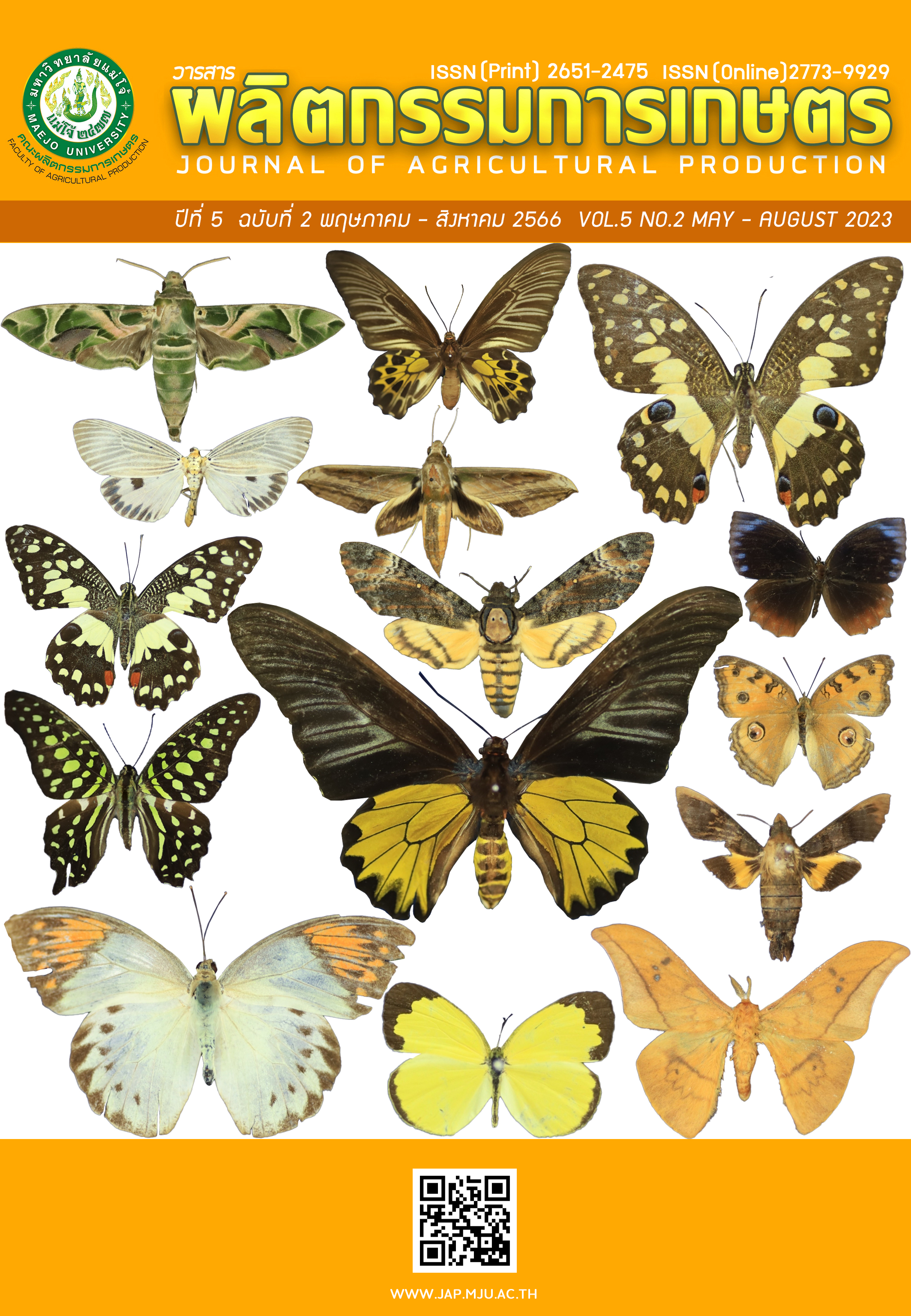ผลของเทคนิคการผลิตรายการวีดิทัศน์ที่ใช้มุมกล้องที่แตกต่างกันต่อการเรียนรู้ของเกษตรกร อำเภอสันทราย จังหวัดเชียงใหม่
Main Article Content
บทคัดย่อ
การวิจัยครั้งนี้มีวัตถุประสงค์เพื่อเปรียบเทียบผลการเรียนรู้ด้านพุทธิพิสัยของเกษตรกร จากการชมรายการวีดิทัศน์ ที่ใช้มุมกล้องที่แตกต่างกัน 3 แบบ คือ (1) รายการวีดิทัศน์ที่ใช้มุมกล้องแบบออบเจกทีฟ (Objective camera angle) (2) รายการวีดิทัศน์ที่ใช้มุมกล้องแบบซับเจกทีฟ (Subjective camera angle) (3) รายการวีดิทัศน์ที่ใช้มุมกล้องแบบพอยต์ออฟวิว (Point view camera angle) การวิจัยใช้การทดลองแบบเปรียบเทียบ 2 กลุ่มขึ้นไป มีการวัดผลการทดลองก่อนและหลัง โดยมีกลุ่มตัวอย่างการวิจัยคือ เกษตรกรในอำเภอสันทราย จังหวัดเชียงใหม่ ซึ่งได้มาจากการสุ่มตัวอย่างแบบหลายขั้นตอน จำนวนทั้งหมด 120 คน แบ่งเป็น 3 กลุ่ม กลุ่มละ 40 คน กลุ่มแรกเรียนรู้จากรายการวีดิทัศน์ที่ใช้มุมกล้องแบบออบเจกทีฟ กลุ่มที่สองเรียนรู้จากรายการวีดิทัศน์ที่ใช้มุมกล้องแบบซับเจกทีฟ กลุ่มที่สามเรียนรู้จากรายการวีดิทัศน์ที่ใช้มุมกล้องแบบพอยต์ออฟวิว เนื้อหาที่ใช้สร้างบทรายการวีดิทัศน์คือเรื่อง “การเสียบยอดมะม่วงพันธุ์ดี” รวบรวมโดยใช้แบบสอบถามและแบบทดสอบ จากนั้นนำข้อมูลมาวิเคราะห์ทางสถิติเพื่อหาค่าร้อยละ ค่าเฉลี่ย ค่าเบี่ยงเบนมาตรฐาน Chi-square, t-test, F-test และ Least Significant Difference (LSD) ผลการวิจัยสรุปได้ดังนี้ 1) ผลการเรียนรู้เชิงพุทธิพิสัยหลังชมรายการวีดิทัศน์ของเกษตรกรทั้ง 3 กลุ่ม สูงกว่าก่อนชมอย่างมีนัยสำคัญยิ่งทางสถิติ โดยผลการเรียนรู้เชิงพุทธิพิสัยหลังชมรายการวีดิทัศน์ของเกษตรกรทั้ง 3 กลุ่ม แตกต่างกันอย่างมีนัยสำคัญทางสถิติ โดยพบว่า เกษตรกรที่เรียนรู้จากรายการวีดิทัศน์ที่ใช้มุมกล้องแบบพอยต์ออฟวิว มีผลการเรียนรู้สูงสุด รองลงมาคือรายการวีดิทัศน์ที่ใช้มุมกล้องแบบซับเจกทีฟ ขณะที่รายการวีดิทัศน์ที่ใช้มุมกล้องแบบออบเจกทีฟ มีผลการเรียนรู้ต่ำสุด 2) เปรียบเทียบความแตกต่างของคะแนนเฉลี่ยแต่ละคู่ ผลปรากฏว่า คะแนนเฉลี่ยของเกษตรกรที่เรียนจากรายการวีดิทัศน์ที่ใช้มุมกล้องแบบออบเจกทีฟ กับรายการวีดิทัศน์ที่ใช้มุมกล้องแบบซับเจกทีฟ ไม่มีความแตกต่างกันทางสถิติ, คะแนนเฉลี่ยของเกษตรกรที่เรียนจากรายการวีดิทัศน์ที่ใช้มุมกล้องแบบซับเจกทีฟ กับรายการวีดิทัศน์ที่ใช้มุมกล้องแบบพอยต์ออฟวิว ไม่มีความแตกต่างกันทางสถิติ และคะแนนเฉลี่ยของเกษตรกรที่เรียนจากรายการวีดิทัศน์ที่ใช้มุมกล้องแบบพอยต์ออฟวิว สูงกว่าเกษตรกรที่เรียนจากรายการวีดิทัศน์ที่ใช้มุมกล้องแบบออบเจกทีฟ มีความแตกต่างกันอย่างมีนัยสำคัญทางสถิติที่ระดับ 0.05
Article Details

อนุญาตภายใต้เงื่อนไข Creative Commons Attribution-NonCommercial-NoDerivatives 4.0 International License.
เอกสารอ้างอิง
Carroll, N. 1993. Toward a theory of point-of-view editing: communication, emotion, and the movies. Poetics Today 14(1): 123-141.
Cummins, R.G., J.R. Keene and B.H. Nutting. 2012. The impact of Subjective camera in sports on arousal and enjoyment. Mass Communication and Society 15(1): 74-97.
Intaratat, K. 2004. Communication Pattern and Strategy for Participatory Development among the Community, The Tambon Agricultural Service and Transfer Center, The Community Learning Center, and Relevant Agencies. Bangkok: Extension and Training Office Kasetsart University. [In Thai]
Khotchum, A. 2019. Development of Video Learning Materials for Occupations and Technology Course Garden Design and Decoration for Mattayomseuksa 2 Level. Journal of Project in Computer Science and Information Technology 5(2): 67-76. [In Thai]
John, R.S. 2013. Photographic Psychology: Image and Psyche. [Online]. Available: http://truecenterpublishing.com/photopsy/article_index.htm (October 22, 2020).
Jungbauer, L. 2018. The Effect of Motion Dynamics and POV shots on Film Viewers’ Narrative Engagement, Empathy and Arousal. (Bachelor thesis Communication and Information Science Specialization: Human Aspects of Information Technology Tilburg University, Tilburg. Netherlands.)
Panpeng, Y. 2016. Movie Creation with a Digital DSLR Camera. [Online]. Available: https://www.chonburi.spu.ac.th/comm/index.php?p=knowledge_detail&detail=774093531 (October 22, 2020). [In Thai]
Pungsri, A. 2018. The Development of Online Video Lesson Subject Photography Technology Tiile “Advance Flash Photography”. (Independent Study M.Ed. in Educational Technology and Communication, Naresuan University, Phitsanulok.) [In Thai]
Quintero, J.M., and A. Sangalang. 2017. Testing the explanatory power of two measures of narrative involvement: An investigation of the influence of transportation and narrative engagement on the process of narrative persuasion. Media Psychology 20(1): 144-173.
Sricharoen, P. 2016. Audience’s Viewing Behavior and Satisfaction of AT TEN DAY Television Program on Channel 3. (Independent Study M.A. in Mass Communication Administration Journalism and Mass Communication Thammasat University, Bangkok.) [In Thai]
Yamongkon, D. 1990. Effects of different camera angles with and without subtitles and main points in video production upon farmer’s skill learning. (Master of Agricultural (Agricultural Extension) Maejo Institute of Agricultural Technology. Chiang Mai.) [In Thai]
Yenjabok, P., S. Saengpetch and T. Sittirangsan. 2004. Agricultural development communication for the new theory of King Bhumipol Adulyadej. Bangkok: The Thailand Research Fund (TRF). [In Thai]


